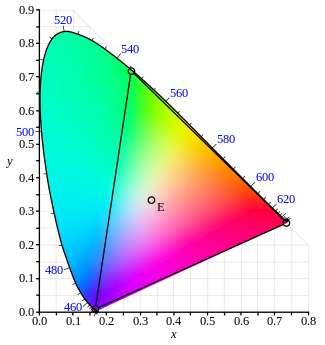
Back الفضاء اللوني سي آي إي 1931 Arabic CIE 1931 XYZ Catalan CIE XYZ Czech CIE-Normvalenzsystem German Espacio de color CIE 1931 Spanish CIE 1931 Estonian فضای رنگ سیآیایی ۱۹۳۱ Persian CIE 1931 XYZ -väriavaruus Finnish CIE XYZ French CIE 1931 XYZ Galician
This article needs additional citations for verification. (May 2019) |



The CIE 1931 color spaces are the first defined quantitative links between distributions of wavelengths in the electromagnetic visible spectrum, and physiologically perceived colors in human color vision. The mathematical relationships that define these color spaces are essential tools for color management, important when dealing with color inks, illuminated displays, and recording devices such as digital cameras. The system was designed in 1931 by the "Commission Internationale de l'éclairage", known in English as the International Commission on Illumination.
The CIE 1931 RGB color space and CIE 1931 XYZ color space were created by the International Commission on Illumination (CIE) in 1931.[1][2] They resulted from a series of experiments done in the late 1920s by William David Wright using ten observers[3] and John Guild using seven observers.[4] The experimental results were combined into the specification of the CIE RGB color space, from which the CIE XYZ color space was derived.
The CIE 1931 color spaces are still widely used, as is the 1976 CIELUV color space.
- ^ CIE (1932). Commission internationale de l'Eclairage proceedings, 1931. Cambridge: Cambridge University Press.
- ^ Smith, Thomas; Guild, John (1931–32). "The C.I.E. colorimetric standards and their use". Transactions of the Optical Society. 33 (3): 73–134. Bibcode:1931TrOS...33...73S. doi:10.1088/1475-4878/33/3/301.
- ^ Wright, William David (1928). "A re-determination of the trichromatic coefficients of the spectral colors". Transactions of the Optical Society. 30 (4): 141–164. doi:10.1088/1475-4878/30/4/301.
- ^ Guild, J. (1932). "The colorimetric properties of the spectrum". Philosophical Transactions of the Royal Society of London. Series A, Containing Papers of a Mathematical or Physical Character. 230 (681–693): 149–187. Bibcode:1932RSPTA.230..149G. doi:10.1098/rsta.1932.0005. JSTOR 91229.
The trichromatic coefficients for [Wright's] ten observers agreed so closely with those of the seven observers examined at the National Physical Laboratory as to indicate that both groups must give results approximating more closely to 'normal' than might have been expected from the size of either group
© MMXXIII Rich X Search. We shall prevail. All rights reserved. Rich X Search